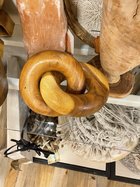-
April 2025 Turning Challenge: Turn an Egg! (click here for details) -
Congratulations to Kelly Shaw winner of the March 2025 Turning Challenge (click here for details) -
Congratulations to Ellen Starr for "Lotus Temple" being selected as Turning of the Week for 21 April, 2025 (click here for details) -
Welcome new registering member. Your username must be your real First and Last name (for example: John Doe). "Screen names" and "handles" are not allowed and your registration will be deleted if you don't use your real name. Also, do not use all caps nor all lower case.
You are using an out of date browser. It may not display this or other websites correctly.
You should upgrade or use an alternative browser.
You should upgrade or use an alternative browser.
Intersecting Rings
- Thread starter Robert Feingold
- Start date
One of the tori was cut and reglued around the other. The gluelines are visible on the right hand ring.
john lucas
AAW Forum Expert
Could have been totally carved. I break one ring and place it around the good ring and glue back together. Done well you cant see the joint. I sent an article in to the journal on turning captured rings and included a lesson on broken rings.
- Joined
- Feb 28, 2021
- Messages
- 1,579
- Likes
- 1,379
- Location
- Roulette, PA
- Website
- www.reallyruralwoodworks.com
Agree with John, It could well have been turned and then carved, I recall not all that long ago, there was a chain goblet selected as turning of the week, and the creator stated they had turned the form/shape on the lathe, then carved the chain links by hand after the basic outer shape of the links had been turned (along with the goblet and foot) It takes a little thought to wrap your head around it, but if you see the actual rough shape profile of the turned piece before the carving is done, it suddenly makes sense..
Wood carving a chain is a fairly old technique and if you google "wood carving a chain" or visit a local wood carving club you can see how it is done. The links are always elongated (just like a real steel chain) such that the individual links can be separated from each other and the grain orientation will be 90 degrees off on consecutive links. The rings in the photo have identical grain orientation and there in not enough difference in size of the hole and the size of the ring to allow them to have been carved/separated from one piece of wood. The most likely way to accomplish that as far as I can see is that one ring must have been broken and glued back together around the other one. Back in the 1970s I made chain using the standard technique where you start with a square length of wood, cut the corners out so the piece has a cross section like a + sign.
It's not so visible if you can't see glue still on the seam like on that work.One of the tori was cut and reglued around the other. The gluelines are visible on the right hand ring.
I see no glue line even at 10X magnification.
john lucas
AAW Forum Expert
I disagree about not having enough space to free the rings when carving. I've carved a chain and had less space than that.Wood carving a chain is a fairly old technique and if you google "wood carving a chain" or visit a local wood carving club you can see how it is done. The links are always elongated (just like a real steel chain) such that the individual links can be separated from each other and the grain orientation will be 90 degrees off on consecutive links. The rings in the photo have identical grain orientation and there in not enough difference in size of the hole and the size of the ring to allow them to have been carved/separated from one piece of wood. The most likely way to accomplish that as far as I can see is that one ring must have been broken and glued back together around the other one. Back in the 1970s I made chain using the standard technique where you start with a square length of wood, cut the corners out so the piece has a cross section like a + sign.
- Joined
- Apr 27, 2004
- Messages
- 9,161
- Likes
- 5,768
- Location
- Lakeland, Florida
- Website
- www.hockenberywoodturning.com
Yes. I may be wrong and I understand that it could be carved but it looks to me like a pair of gluelines.
The biggest thing telling be it was broken and glued is the wood grain is too dissimilar. If it were carved from one piece you would expect at some point a continuity of the colors and grain patterns from one to the other.
There was a meeting of the International Wood Collector's Society, or some name like that, here in town a number of years back. They all had link chains of all their different woods. It was pretty impressive.
robo hippy
robo hippy
john lucas
AAW Forum Expert
Oh I'd love to do interlocking dissimilar woods.


